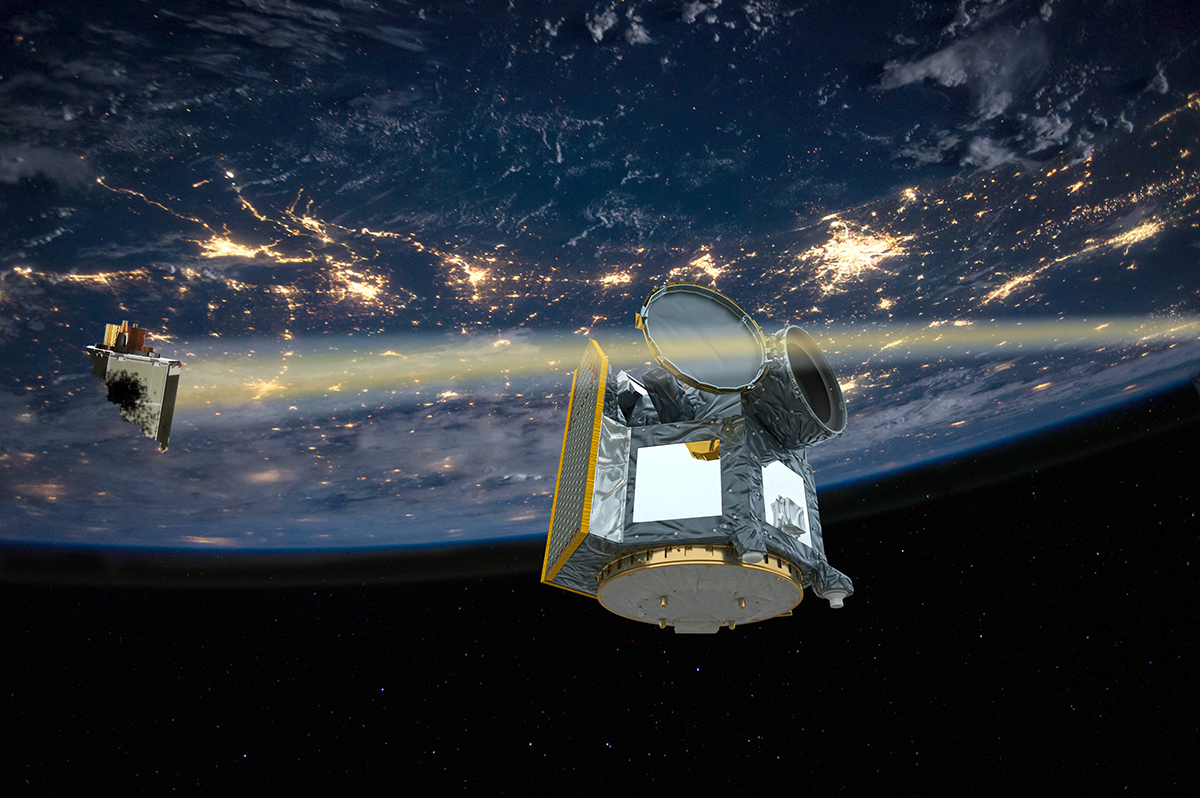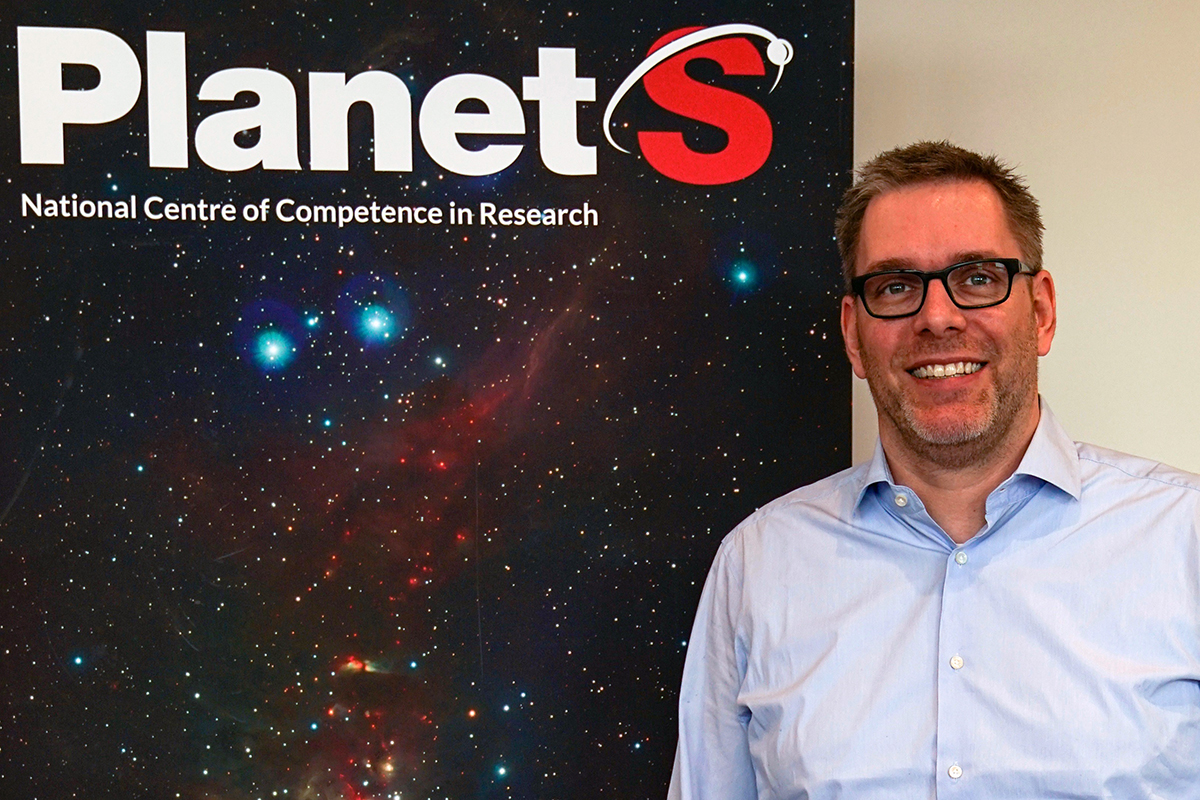CHEOPS had to avoid space debris
Space debris increasingly threatens rockets, the international space station and satellites. At the beginning of October, the CHEOPS space telescope had to make an evasive manoeuvre due to a piece of Chinese space debris.

"On 30 September at 15 hrs, ESA's Space Debris Office informed us that a piece of space debris was on a collision course with the CHEOPS space telescope," says Dr Christopher Broeg, CHEOPS Project Manager at the University of Bern. Just two days later, the piece of junk from the faulty Chinese satellite Fengyun 1C, which is about the size of a milk carton, was to rush past the ESA satellite.
Danger of destruction of the CHEOPS space telescope
Such approaches can be extremely dangerous, because objects in Earth orbit shoot through space at many times the speed of a bullet. If a piece only 1 cm in diameter collides with another object, the energy of an exploding hand grenade is released.
In the case of CHEOPS, the calculations showed that at its closest approach, the piece of debris would come within a dangerous 500 metres of the space telescope. The radial distance would have been only 13 metres. The probability of a collision: 1:10,000. "This may not seem very dramatic at first glance. But at the enormous speeds of the satellites, a minimal orbit deviation can have fatal consequences," explains Broeg. "In the event of a collision with the Chinese part of the satellite, this could have meant the destruction of the CHEOPS space telescope".

Collision warning by the European Space Agency ESA
ESA's Space Debris Office keeps track of thousands of pieces of debris flying around uncontrolled in an Earth orbit. If one comes close to an active satellite or space capsule, the office issues a warning and proposes an orbit correction.
Usually, such collision warnings are issued 3 to 7 days before the object's next approach. In the current case, the warning was issued at very short notice, which meant that a decision had to be made quickly to take evasive action. Since contact with the satellite is only made twice a day, the command for orbit correction had to be sent to the CHEOPS on-board computer half an earth orbit earlier.
"We decided on an orbit 56 metres below the previous orbit", says Christopher Broeg. For the course correction, the instrument had to be shut down on 1 October for safety reasons. On 2 October at 0:52 UTC, the on-board computer ignited the controlling thrusters of CHEOPS for 1.5 seconds and successfully corrected the orbit. The space telescope was then able to return to operating mode. The piece of debris finally flew past CHEOPS on 2 October at 1:41 UTC at a relative speed of 3,140 metres per second at a distance of around one kilometre without causing any damage.
In the mission planning, it was assumed that there would be a maximum of three collision warnings per year and an effective orbit correction. "For the CHEOPS team, this was the first warning, which is why the tension was high at the beginning," says Broeg.
And the balance of the incident? CHEOPS consumed a negligible amount of fuel; one day of observation time was lost and the observation plan had to be recreated.
CHEOPS – in search of potential habitable planets
The CHEOPS mission (CHaracterising ExOPlanet Satellite) is the first of ESA’s newly created “S-class missions” – small-class missions with an ESA budget much smaller than that of large- and medium-size missions, and a shorter timespan from project inception to launch.
CHEOPS is dedicated to characterizing the transits of exoplanets. It measures the changes in the brightness of a star when a planet passes in front of that star. This measured value allows the size of the planet to be derived, and for its density to be determined on the basis of existing data. This provides important information on these planets – for example, whether they are predominantly rocky, are composed of gases, or if they have deep oceans. This, in turn, is an important step in determining whether a planet has conditions that are hospitable to life.
CHEOPS was developed as part of a partnership between the European Space Agency (ESA) and Switzerland. Under the leadership of the University of Bern and ESA, a consortium of more than a hundred scientists and engineers from eleven European states was involved in constructing the satellite over five years.
CHEOPS began its journey into space on Wednesday, December 18, 2019 on board a Soyuz Fregat rocket from the European spaceport in Kourou, French Guiana. Since then, it has been orbiting the Earth on a polar orbit in roughly an hour and a half at an altitude of 700 kilometers following the terminator.
The Swiss Confederation participates in the CHEOPS telescope within the PRODEX programme (PROgramme de Développement d'EXpériences scientifiques) of the European Space Agency ESA. Through this programme, national contributions for science missions can be developed and built by project teams from research and industry. This transfer of knowledge and technology between science and industry ultimately also gives Switzerland a structural competitive advantage as a business location – and enables technologies, processes and products to flow into other markets and thus generate added value for our economy.
More information: https://cheops.unibe.ch
Bernese space exploration: With the world’s elite since the first moon landing
When the second man, "Buzz" Aldrin, stepped out of the lunar module on July 21, 1969, the first task he did was to set up the Bernese Solar Wind Composition experiment (SWC) also known as the “solar sail” by planting it in the ground of the moon, even before the American flag. This experiment, which was planned and the results analysed by Prof. Dr. Johannes Geiss and his team from the Physics Institute of the University of Bern, was the first great highlight in the history of Bernese space exploration
Ever since Bernese space exploration has been among the world’s elite. The numbers are impressive: 25 times were instruments flown into the upper atmosphere and ionosphere using rockets (1967-1993), 9 times into the stratosphere with balloon flights (1991-2008), over 30 instruments were flown on space probes, and with CHEOPS the University of Bern shares responsibility with ESA for a whole mission.
The successful work of the Department of Space Research and Planetary Sciences (WP) from the Physics Institute of the University of Bern was consolidated by the foundation of a university competence center, the Center for Space and Habitability (CSH). The Swiss National Fund also awarded the University of Bern the National Center of Competence in Research (NCCR) PlanetS, which it manages together with the University of Geneva.
About Christopher Broeg

Dr. Christopher Broeg has been CHEOPS Project Manager at the University of Bern since 2012. He studied physics at the Technical University of Munich (TUM), did his diploma thesis at the Max Planck Institute for Extraterrestrial Physics (MPE) in Munich and received his doctorate in 2006 at the Friedrich Schiller University (FSU) in Jena. The goal of his dissertation was to develop a prediction of possible planetary populations around other stars. In 2007 he joined the University of Bern as a postdoctoral fellow.
Contact:
Dr. Christopher Broeg
Universität Bern. Center for Space and Habitability (CSH) und NCCR PlanetS
Tel: +41 78 715 76 77
christopher.broeg@space.unibe.ch
About the author
Guido Schwarz works as Deputy Head of Communication at the National Centre of Competence in Research (NCCR) PlanetS, which is based at the University of Bern and the University of Geneva.